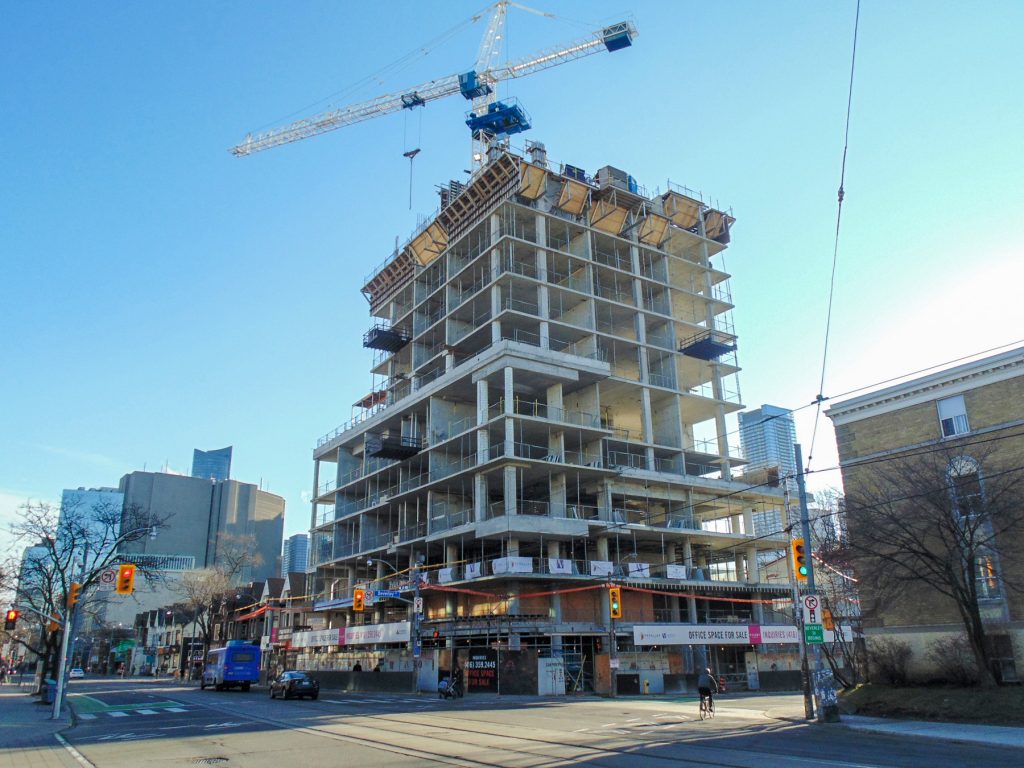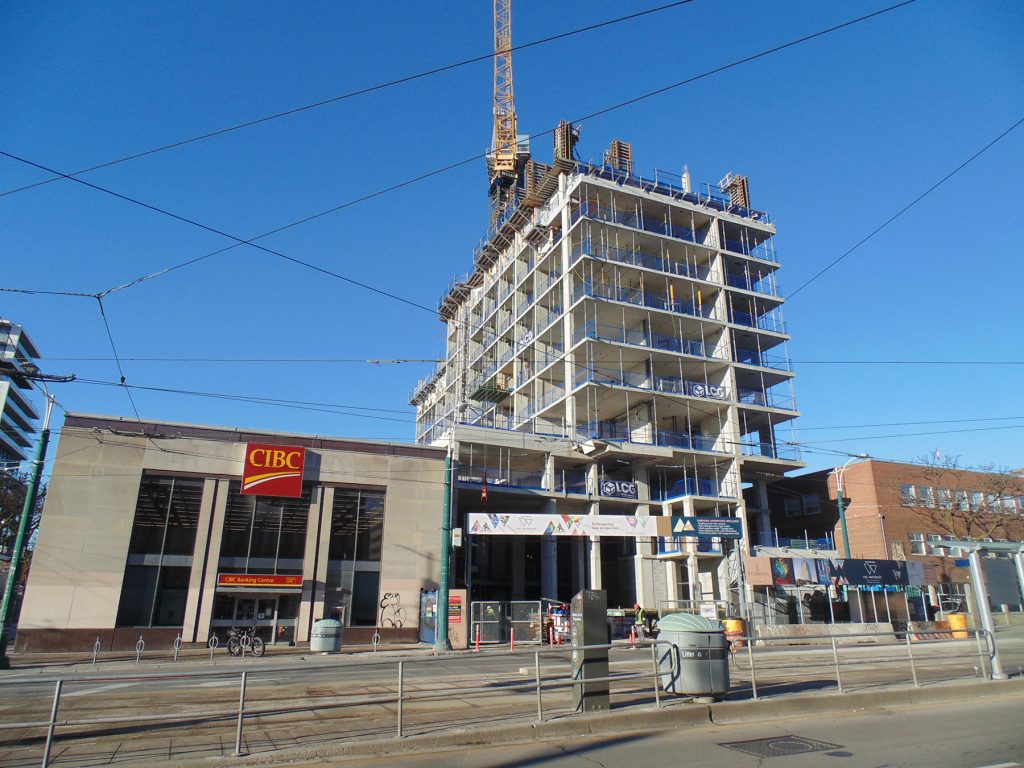Tall structures can curb urban sprawl

In May 2020, the Annex Gleaner celebrates 25 years of publishing. In celebration, we are republishing highlights of our past; this feature, Fear of High Buildings Groundless by city-building columnist Alfred Holden, is from May 2001. As thirteen developments are going up in the Annex area it appears Holden’s views were prophetic.
By Alfred Holden
Howard Cohen and I have lunch together sometimes. He’s the only developer I can talk to – he “gets” the city, rides the streetcars, passes me clippings from the New York Times and, like a journalist, thinks he can earn his living and make the town a better place at the same time.
Cohen is a former City of Toronto planner who now builds condominiums. Many are in or near Gleaner territory, among them 20 Niagara St., the nearly-completed District Lofts near Richmond St. W. and Spadina Ave., and the Ideal Lofts, now under construction on College St., just west of Bathurst.
Without exception the buildings, which have been designed by a team headed by architect Peter Clewes, are clean and contemporary – boldly, bravely so, when you consider how most developers seem to think the public only wants “wedding cake” condos: buildings dripping curlicues and baroque ornament.
Ideal Lofts is in a better class. It has potential to live up to its name, as good design in and of itself – there’s a lot of glass, and glass is great – and it is a nicely-fitted addition to the bustling streetcar strip it will be part of.
On College St. Ideal Lofts’ front – clean and square like old factories nearby – rises right from the sidewalk, continuing the shop facades. Up a few floors Ideal steps back and then back again, yielding open terraces for residents and angles that let more sun down to the street.
At the back, the building’s nine or so storeys step down until the ideal blends at roof-level with the single-family homes to the south on Markham St.
Ideal, eh? By all rights, Howard Cohen should be the hero of neighbourhood groups.
But at the moment he’s not.
Cohen’s firm, Context Development Inc., is the one that’s butting heads with various groups over plans for a condominium on the grounds of St. James Cathedral, east of Yonge St. at Adelaide and Church streets.
It’s all a bit iconic: Context was chosen by the church’s board, from a number of potential developers, because of the higher-grade city-building that it has been doing.
Now they are in the hot seat.
Complicating factors, hugely, is the historic nature of the site, including the proposed demolition of the attractive parish hall there, and the presence of an old burial ground.
There is no easy way to resolve these matters.
But a key anxiety here is a deep-rooted bias against tall buildings. The original proposal for the site called for a 34-storey tower.
Enough said. You can hear the anger and the catcalls rising – the arguments about increased traffic; the angst about “crowding” in the city; the fury over the sacred god – the church – under siege by the secular one, money.
Yet time and experience and change are telling us our fear is unjustified, and ultimately harmful to the city.
Building up, not out, is the solution to a range of issues related to sprawl, transportation, pollution, long-term stewardship of land and, closer to our streets, improved quality of urban and community life.
Ideal shows how it can be done – what a long way Toronto’s planners, architects, and better developers have come since the 1960s and 70s, when angst reached its apex in an emergency height limit slapped on the city’s downtown development.
At the time the norm, indeed the requirement, was to blockbust – buy up the houses, shops, everything on entire blocks, bulldoze them and erect the era’s famous “towers in the park”.
“Open spaces” were somehow to redeem the buildings’ height. But at places like St. Jamestown near Parliament and Wellesley streets, the “parks” became empty, windswept, and ugly. All the demolition and destruction, and the disappointing city spaces that resulted, earned tall buildings a bad rap.
Fast-forward to 2001. Design principles have changed, but the terror over tall remains. Witness public upset over plans for two tower condominiums at Yonge St. and Eglinton Ave.
Here too is interesting irony.
The progressive left that once decried development and opposed towers now supports greater urban density – “Mainstreeting”, or building more compactly, building up not across, infilling, not sprawling.
The right-wing now owns the kind of properties it once blockbusted and has embraced NIMBY – not in my back yard. The headline on a National Post story about Minto’s Yonge-Eglinton point-tower project said simply, “Up is Down.”

Yet neighbours are not threatened; those battles are still won. The need to weigh scale and context is embedded – as Howard Cohen has demonstrated. “You don’t want point towers at College and Bathurst,” he told me over coffee in his office in the Ryrie Building on Yonge St.
Some problems, like shadows, have serendipitous solutions. A tall thin tower, for instance, may yield a twenty-minute shadow; a lower long slab-building can cast darkness that lasts all day.
Some issues, such as traffic and parking, are proved moot with high buildings. Witness the mid- and high-rise Spadina Rd. and St. George St. apartment houses, where garage space can be rented by the public because many tenants living close to the subway, or who walk, don’t have cars.
Finally, at another level, the architectural opportunities created by tall buildings – for grandness, for innovations, for buildings that support modern life and embrace urbanity – are many, and not always predictable.
One of New York’s best-known images is of the Trinity Church at Wall St. and Broadway, with its spire nestled among the skyscrapers.
In Toronto, “I walk under this building, and its freedom,” Inez Zangger, a guest from Switzerland, told me last month while he walked through Commerce Court, where Toronto skyscrapers reach their peak. “Looking up, you see that anything is possible.”
Yet fear of heights persists in Toronto’s heart. “Sometimes,” Cohen tells me, “it seems like people (downtown) want Mississauga in the city.”
It’s time we grew up.
READ MORE BY ALFRED HOLDEN:
- FROM THE ARCHIVES): Changing the character of 44 Walmer Rd. (Dec. 2017
- FROM THE ARCHIVES: Sculptor marks the lessons of war (November 2016)
- FROM THE ARCHIVES: A grand gesture in the age of thrift (September 2015)
- FOCUS: Urban Elms (September 2015)

1 response so far ↓
1 NEWS: Affordable housing brought to Bathurst (Feb. 2020) // Feb 27, 2020 at 3:36 pm
[…] THE ARCHIVES: Fear of high buildings groundless (Feb. […]